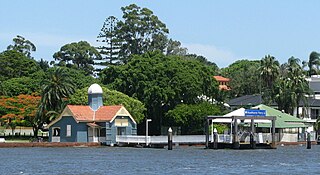
Kangaroo Point is an inner southern suburb in the City of Brisbane, Queensland, Australia. In the 2016 census, Kangaroo Point had a population of 8,063 people.

Bulimba ferry wharf is a heritage-listed ferry wharf at Oxford Street, Bulimba, City of Brisbane, Queensland, Australia. It is located on the southern side of the Brisbane River serving the Brisbane suburb of Bulimba. It is served by RiverCity Ferries' CityCat service and the Cross River service to Teneriffe. It was designed by GHM Addison and Son and built in 1922 by E Taylor. It is also known as Bulimba ferry house and Bulimba waiting shed & landing. It was added to the Queensland Heritage Register on 12 January 2003.

Teneriffe ferry wharf is located on the northern side of the Brisbane River serving the Brisbane suburb of Teneriffe in Queensland, Australia. It is served by RiverCity Ferries' CityCat service and a Cross River service to Bulimba.

Hawthorne ferry wharf is a heritage-listed ferry wharf located on the southern side of the Brisbane River serving the Brisbane suburb of Hawthorne in Queensland, Australia. It is served by RiverCity Ferries' CityCat services. It was added to the Queensland Heritage Register in 2003.

Eagle Street Pier ferry wharf is located on the northern side of the Brisbane River serving the Brisbane central business district in Queensland, Australia. It was served by Transdev Brisbane Ferries' CityHopper service and a cross-river service to Kangaroo Point .These services were suspended in July 2020 and formally cancelled to stop at this wharf in October 2020.

Riverside ferry wharf is located on the northern side of the Brisbane River serving the serving the Brisbane central business district in Queensland, Australia. It is served by RiverCity Ferries' CityCat services. From 15 November 2020 it is also being served by CityHopper and Cross River services.

QUT Gardens Point ferry wharf is located on the northern side of the Brisbane River serving the Brisbane central business district in Queensland, Australia. It is served by RiverCity Ferries' CityCat services.

Thornton Street ferry wharf was a ferry terminal located on the southern side of the Brisbane River serving the Brisbane suburb of Kangaroo Point in Queensland, Australia. It was served by Transdev Brisbane Ferries' CityHopper service and the cross-river service to Eagle Street Pier in the Brisbane central business district. These services were suspended in July 2020 and the wharf was permanently closed in October 2020.

South Bank 1 & 2 ferry wharf is located on the southern side of the Brisbane River serving the Brisbane suburb of South Brisbane in Queensland, Australia. The wharf consists of two jetties, numbered 1 and 2 are used by RiverCity Ferries' CityCat services.

Regatta ferry wharf is located on the northern side of the Brisbane River serving the Brisbane suburb of Toowong in Queensland, Australia. It is served by RiverCity Ferries' CityCat services.

Transdev Brisbane Ferries, formerly Metrolink Queensland and TransdevTSL Brisbane Ferries, was the operator of the CityCat, CityHopper, and Cross River ferry networks on the Brisbane River in Brisbane, Queensland, Australia from November 2003 until November 2020. The network, operated under contract to the Brisbane City Council, formed part of the TransLink integrated public transport scheme.

Bulimba is a suburb in the City of Brisbane, Queensland, Australia. In the 2016 census Bulimba had a population of 6,843 people.

Ferry transport in Queensland provides both historical and current information relating to scheduled public passenger ferry services in Queensland. The first ferry started on 1 January 1843 at Russell Street with a service across the Brisbane River.

Petrie Bight is a reach of the Brisbane River in Brisbane, Queensland, Australia. The land to the north of the bight, centred on the area under the Story Bridge's northern point and around the Brisbane River to Customs House is also known as Petrie Bight and was formerly a suburb of Brisbane. The area whilst still informally known as Petrie Bight, was absorbed into the suburbs of the Brisbane CBD and Fortitude Valley during consolidation of suburbs by the Brisbane City Council. With a resurgence in Brisbane residents interested in this part of the city and its history, has meant there is a possibility the Brisbane City Council and Queensland Government may once again reinstate Petrie Bight as a suburb to give the area a better sense of identity.

Howard Smith Wharves is a heritage-listed wharf on the Brisbane River at Boundary Street, Brisbane City and Fortitude Valley, City of Brisbane, Queensland, Australia. It was built from c. 1934 to 1940s circa. It is also known as Brisbane Central Wharves. The 3.5-hectare (8.6-acre) site is one of the most culturally and historically significant riverfront locations in Brisbane. It was added to the Queensland Heritage Register on 4 February 1997.

Northshore Hamilton ferry wharf is located on the northern side of the Brisbane River serving the Brisbane suburb of Hamilton in Queensland, Australia. It is the downstream terminus for RiverCity Ferries' CityCat services.

Milton ferry wharf is located on the northern side of the Brisbane River serving the Brisbane suburb of Milton in Queensland, Australia It is served by RiverCity Ferries' CityCat services.

Bulimba Reach is a reach of the Brisbane River in Brisbane, Queensland, Australia.

The Moreton Bay Penal Settlement operated from 1825 to 1842. It became the city of Brisbane, Queensland, Australia.

RiverCity Ferries is a public transport company which commenced operating ferry services in Brisbane on 4 November 2020. It is a subsidiary of the SeaLink Travel Group.























